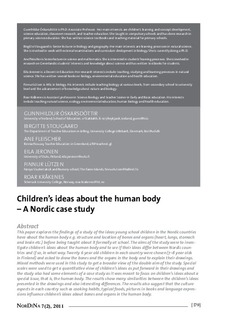Children's ideas about the human body - A Nordic case study
Óskarsdóttir, Gunnhildur; Stougaard, Birgitte; Fleischer, Ane; Jeronen, Eila; Lützen, Finnur; Kråkenes, Roar
Journal article, Peer reviewed
Published version
Permanent lenke
http://hdl.handle.net/11250/2438177Utgivelsesdato
2011Metadata
Vis full innførselSamlinger
- Institutt for pedagogikk [285]
Originalversjon
?skarsdóttir, G., Stougaard, B., Fleischer, A., Jeronen, E., Lützen, F. & Kråkenes, R. Children's ideas about the human body - A Nordic case study. NorDiNa - Nordic Studies in Science Education, 2011, 7(2), p. 179-188Óskarsdóttir, G., Stougaard, B., Fleischer, A., Jeronen, E., Lützen, F. & Kråkenes, R. Children's ideas about the human body - A Nordic case study. NorDiNa - Nordic Studies in Science Education, 2011, 7(2), p. 179-188
Sammendrag
This paper explores the findings of a study of the ideas young school children in the Nordic countries have about the human body e.g. structure and location of bones and organs (heart, lungs, stomach and brain etc.) before being taught about it formally at school. The aims of the study were to investigate children’s ideas about the human body and to see if their ideas differ between Nordic countries and if so, in what way. Twenty 6 year old children in each country were chosen (7–8 year olds in Finland) and asked to draw the bones and the organs in the body and to explain their drawings. Mixed methods were used in this study to get a broader view of the double aim of the study. Special scales were used to get a quantitative view of children’s ideas as put forward in their drawings and the study also had some elements of a case study as it was meant to focus on children’s ideas about a special issue, that is, the human body. The results show many similarities between the children’s ideas presented in the drawings and also interesting differences. The results also suggest that the culture aspects in each country such as cooking habits, typical foods, pictures in books and language expressions influence children’s ideas about bones and organs in the human body.
